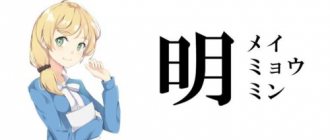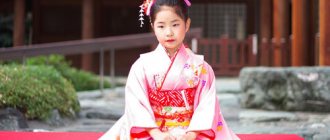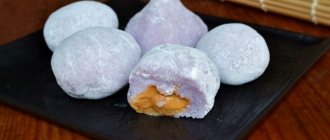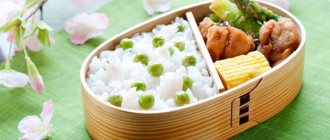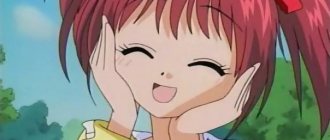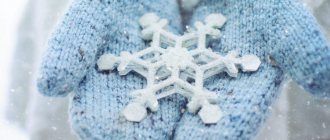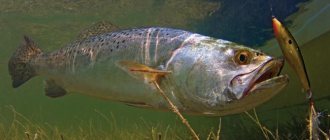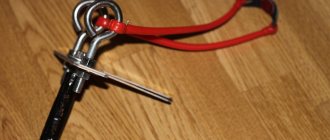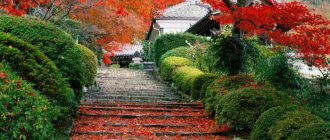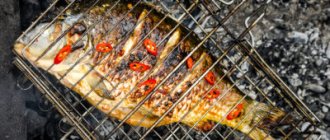History of the Kishu breed
Kishu dogs first appeared on the island of Hokkaidu in the mountainous region of Kishu Province. The exact homeland of the breed is Wakayama Prefecture. Thus, Kishu dogs are indigenous.
The breed has been known since the Middle Ages. In those days, kisyu were actively used in hunting various animals, including wild boars and deer. Thus, even the mountain climate allowed the dogs to acquire a strong character and real resistance to various life circumstances. The natural conditions in which the breed began to develop determined the appearance of high-quality warm wool, which is protection from cold days and frosty nights.
Kishu is a native dog that originated in Japan. True Japanese are confident that the breed can be associated with a true concept of the spirit of the entire people, a devoted attitude, a readiness for brave deeds and true devotion. Kishu are amazing dogs, so it is not surprising that the Japanese compare themselves to them.
Since ancient times, there has been a special attitude towards the Japanese Kishu breed. Puppies should live in a comfortable home and be as close to people as possible. Adult dogs should not live in the backyard, as such conditions will immediately humiliate any representative of the kitty. Every pet should feel that it remains needed and important to its owners.
Kishu Inu - origin of the breed
The origin of this breed occurred on the island of Honshu, where to this day
Today this breed is very numerous. For people who have not encountered such a breed before, it will outwardly resemble an Akita or Shikoku. In the 20th century, this breed almost disappeared, but thanks to Mr. Harue Izogai, who petitioned the government to assign this breed the status of a dog protected by law, then the breed was saved. The first representatives of the Kishu Inu had many colors: brindle, brown, sesame. But according to the modern standard, there is only one color for Kishu Inu dogs; all others are considered defective.
General characteristics of Kishu
Kishu is a northern sled dog related to the primitive Spitz. At the same time, one can note the amazing devotion of each representative of the breed. It is important to note that kisyu is actively used for hunting, since the peculiarities of living conditions in the northern region contributed to the development of a hardened and persistent character of the pet.
The color can be different, but in any case the kishu is amazingly beautiful:
- White.
- Brindle.
- Sesame.
- Ginger.
Weight and height are determined by the gender of the pet. In this case, it is not the dog’s living conditions that play a role. Weight, as well as height, is always determined at the genetic level for each representative of the breed.
Dimensions are always based on the withers:
- Males - up to 45 centimeters.
- Bitches - up to 40 centimeters.
Another important physical criterion is the dog’s weight. At the same time, males can weigh up to 25 kilograms, and females – up to 20 kilograms. Kishu in most cases lives about 14 – 15 years . At the same time, the exact life expectancy is determined largely by the living conditions of the pet, which requires high-quality and constant care.
Japanese Chin
We should start the review with the most charming Japanese dog, which has long taken a place in the hearts of a large number of people. We are talking about the Japanese Chin. This little dog is so cute, active and playful that it simply has no equal among miniature pets. Only the Pekingese could compete with her, but his short legs and heavy landing simply do not allow him to catch up with the perky, self-confident and light little one.
The Japanese Chin is filled with a sense of self-importance and wants to be the center of everyone's attention, so it becomes very upset if its own attention is rejected. For more than 1000 years, chins belonged only to the imperial family, being royal favorites. One of the emperors even ordered them to be worshiped, declaring the dogs sacred. They had their own servants and doctors, and only members of the imperial family could own them. Especially miniature specimens were kept in cages, in a suspended state. A pair of Chins was given to Queen Victoria in 1853, which influenced the further development of the breed.
The Japanese Chin is unusually graceful, with a proud posture and luxurious coat. The coat color can be white with either black spots or red markings. The more distinct and brighter the red color, the better it is considered. The spots on the head and ears should be placed symmetrically relative to each other. Some believe that chins are descendants of a lion and a butterfly: they really look like a lion with their muzzles and are mobile, fluttering like butterflies.
Standard
The Japanese Kishu dog breed has certain standards:
- Height – 43 – 56 centimeters.
- Weight – 20 – 27 kilograms.
- The body is small.
- The wool is characterized by its minimum length, stiffness, and straight structure.
- A dense undercoat is provided, which guarantees maximum protection for the dog even in severe frosts.
- Standard color is white. It is important to note that the blood of Kishu flows from other breeds, namely Kai, Shikoku Ainu, so the coat can be brindle or beige. Although there are other coat colors, only white meets the standard.
- The tail and cheeks have longer fur;
- The shape of the head is wide and wedge-shaped.
- The shape of the erect ears is triangular.
- The bite has a scissor-shaped bite. In this case, the upper and lower incisors close together, resulting in a zigzag without the slightest gap.
- Kishu belongs to the 5th group of dog breeds.
Appearance
Kishu is a medium-sized dog, strongly built, compact, and well-balanced. It has a wedge-shaped head typical of Japanese breeds, erect ears and a well-furred tail, which curls into a ring on the back or hangs down like a sickle. Sexual dimorphism is well expressed.
- Height at the withers of males - 52 cm, weight - 20-27 kg;
- The height at the withers of the bitches is 46 cm, weight is 14-23 kg.
The head is of proportional size with a wide forehead and a rather sharp stop. The muzzle is shaped like a tapering wedge. The nose is black; in white dogs it may be flesh-colored. The bridge of the nose is straight. Lips fit tightly. Scissor bite. The eyes are small, triangular in shape, dark brown in color, and widely spaced. The ears are triangular in shape, small, erect, slightly tilted forward. The neck is massive and muscular.
Body with strong bones and well-developed muscles. The height to length ratio is 10 to 11. The back is straight and short. The loin is wide. The chest is deep with moderately sprung ribs. The belly is well tucked. The tail is set high, reaching the hocks, thick, carried in a sickle shape or curled in a ring over the back. The limbs are straight, strong, with strong bones and joints. Paws with tightly knit toes, thick and elastic pads. The claws are strong, preferably black.
The coat is straight, coarse with a soft and dense undercoat. The hair on the cheekbones and tail is longer. Colors:
- White;
- Red (rich red);
- Sesame (sesame) - red or fawn coat with black tips on the hairs.
The brindle color has not been seen in the breed since 1945. Probably, its abandonment is due to the use of the dog for hunting. Whites are more noticeable in the forest and on the back of a dark animal.
General description of the Kishu breed
Kishu is an intelligent dog that is ready to show decent hunting abilities. At the same time, representatives of this breed are initially distinguished by their friendly character. The main character traits contribute to the fact that a pet can be a good protector for housing and household members, ready to become a faithful friend.
Despite the fact that Kishu is distinguished by special patience in many circumstances and amazing endurance, friendliness and affability, many strangers note distrust. It is important to note that such distrust is due only to the fact that by nature representatives of the Japanese Kishu breed must perform protective tasks at a decent level.
Kishu requires long, long walks. At the same time, a dog can be successfully kept even in an ordinary city apartment.
Japanese Akita
The second most important and popular breed, and maybe even the first, is the character from the Hollywood film “Hachiko”, based on real events. Shocked by the devotion and love for his owner shown by the Akito Inu dog, who waited for him for all 8 years until his death, the Americans wanted the same devoted friends to live in their homes. Residents of the United States, through targeted crossbreeding with larger dogs, even developed the American Akita, or Big Akita, breed, which, at the request of the Japanese side, was separated into a separate category in 1988.
Japanese Akita is one of the most famous Japanese Spitz breeds. It was once bred to hunt wild animals, so to this day a dog of this breed is capable of a fierce attack and formidable defense. Based on these qualities, the dog is used mainly for protection. The dog is easy to train and has an even temperament. Akito Inu is affectionate with the whole family, although he is a reserved and proud dog, absolutely fearless. It has small membranes between its toes, which allows the dog to swim well.
Today, Japanese Akita serves as a symbol of Japan, and its figurine, received as a gift, is considered to bring happiness and health.
Despite its many advantages, such a dog is not suitable for everyone: it needs strict training, a lot of physical activity and a carefully selected diet. In addition, this magnificent watchdog needs active socialization and needs to be walked for at least 2 hours a day.
Kishu character
Kishu is a talented dog breed . This is proven by the fact that many Kishu representatives have not only decent hunting qualities. Since ancient times, the best representatives of the breed can delight with their ability to fish and their ability to work as a shepherd.
The character can be somewhat rude and cold. At the same time, aggression cannot be felt. The coldness in character is determined by the history of the breed and its purpose.
Training is not that easy to do. This is due to indifference, arrogance and self-confidence, a developed hunting instinct. At the same time, the possibility of achieving better results in training is guaranteed. The most basic goal is to demonstrate persistence in training and a respectful attitude. Any disrespect causes complete failure in raising a kitty.
Pets can be loyal and protective towards their owners. But given the Nordic nature of kishu, it is extremely important to show tact. Kishu are willing to play with children as long as cuddling is not allowed. Respect is the basis of a good relationship with Kishu dogs.
Training
Despite the above advantages of the Akita Inu, their character is also distinguished by such features as some independence and independence. Therefore, having decided to start training a pet, the owner will have to be patient and persistent. Huskies, due to their natural mobility and activity, can find it difficult to concentrate on the owner’s commands; the animal will constantly be distracted by something. Therefore, the use of harsh training methods will not bring any results other than a damaged relationship with your pet.
Only perseverance and perseverance will bear fruit.
But you need to start basic education of a puppy at the age of two months, so that in the future the owner will not have problems with the pet’s disobedience.
Care and maintenance
Kishu require special care. What principles should the content be based on?
- The coat needs to be cleaned and combed regularly. Thorough cleaning of the coat, which involves the use of a brush, is required after walks. Frequent washing is not recommended, as otherwise there is a risk of skin irritation. It is best to clean the fur with a brush and wipe it with a damp towel. The presence of dead hairs is not allowed.
- Ears need good cleaning. Otherwise, there is a risk of developing ear diseases, which can even lead to deafness.
- A mandatory procedure is trimming the claws using special scissors. Trimming nails too short can damage blood vessels.
- Physical activity should be regular. At the same time, it is recommended to observe moderation.
Japanese Terrier (Nihon Terrier, Mikado Terrier, Oyuki Terrier)
- The official name is Japanese Terrier.
- FCI classification – group 3, section 2, standard No. 259.
- Origin and patronage - Japan.
- Dimensions: 30–33 cm.
The terrier is a hunting dog that works in a hole. A breed with an unexpected appearance for Japanese breeds - short-haired, with semi-erect ears and an elongated set. In Japan, burrow hunting was not developed, but terriers brought by Dutch traders aroused the interest of Japanese breeders. Having decided to create their own breed, with the appearance of a terrier and the disposition of a companion, the breeders mixed the blood of Italian Greyhounds, Pointers and Fox Terriers with imported hunting dogs.
Health (possible diseases)
Negative manifestations that may indicate health problems:
- Insufficient sexual dimorphism.
- Excessively long fur.
- Aggressiveness or cowardice, timidity.
- Malocclusion.
- Irregular tail shape: drooping or short.
- Excessively floppy ears.
The most common diseases of Kishu:
- Arthritis.
- Hip dysplasia.
- Dislocation of the kneecap.
- Gastric torsion.
Feeding
Kishu has an unpretentious attitude towards food . Despite this, many owners take care of their pets and try to properly organize their diet. Various nutritious feeds are an ideal option, because they are distinguished by the balance of all valuable substances, components and minerals.
Only in the first months of life is it recommended to focus on low-fat fermented milk products, high-quality boiled meat and vegetables. At an older age, it is allowed to include food in the diet taking into account the activity of dogs, semi-cooked and raw meat, dietary and nutritious cereals.
The diet should be aimed at keeping dogs active.
Reviews
You can find many reviews about Japanese huskies on the Internet; we will publish only a few of them. Anna Petrovna, Khabarovsk:
- “I was always against dogs in the apartment, until my daughter brought such a cute puppy that I couldn’t resist. Our Rose changed my understanding of dogs. This is a very touching, obedient, affectionate animal, which must be treated responsibly and given time. I can't even call her a pet. She became part of our family."
Andrey Petrovich, breeder from Vladivostok:
- “The Japanese Husky is not made for an apartment and many people forget about this or don’t even want to think about it. This is a large working dog, accustomed to serious workloads, and not a cat who can curl up on the windowsill and sleep all day. If you want to have an Akita Inu, then think not only about your desires, but also about the needs of the pet, and soberly assess your capabilities.”
